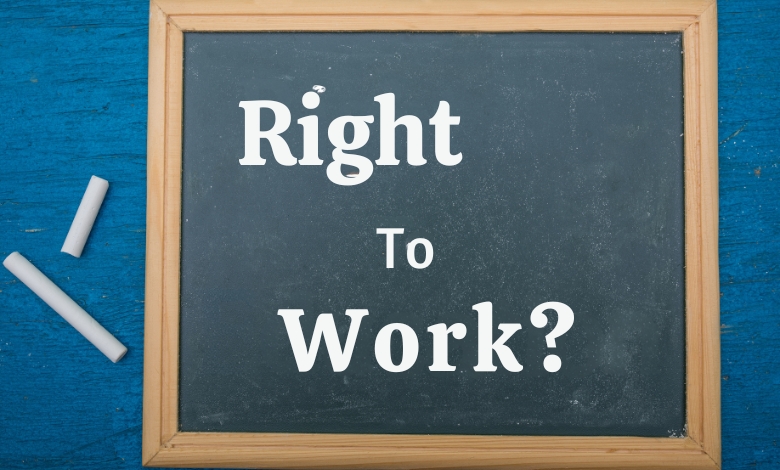Discover the pros and cons of Right-to-Work law and their impact on workers and businesses in this insightful article.
First learning about right-to-work laws, I was chatting casually with a buddy in human resources.
She noted how the implementation of these rules by her state had fundamentally impacted the nature of the workplace.
Intrigued, I looked further into this divisive subject, which set off a continuous discussion on workers’ rights, union authority, and economic consequences.
We shall discuss in this post what right-to-work legislation are, their advantages and drawbacks, and their wider consequences.
Let’s get started.
Article Breakdown
What is the Right to Work Law?

Legislation allowing workers to work without being forced to join a union as a prerequisite of employment is known as the right-to-work law. It basically allows employees the opportunity to decide whether or not they wish to financially support a union or join itself. State-by-state variations in this legislation have significant impact on worker rights and unions.
Historical Context
Examining the Labor Management Relations Act of 1947, sometimes known as the Taft-Hartley Act, helps us to grasp the beginnings of the right-to-work law. States were free under this federal statute to enact their own right-to-work laws, which in turn forbade agreements between unions and companies whereby membership or payment of union dues was a prerequisite of employment.
Modern Implications
These statutes now apply in 27 states in the United States, each of which executes its own variant of the legislation. These rules have split views among those who contend they undermine unions and jeopardize worker unity and others who say they encourage personal freedom.
How Do Right to Work Laws Diminish Union Power?
The effect of right-to-work laws on unions is among the most important objections leveled at them. These rules greatly limit the financial resources available to unions by letting workers choose not to pay dues or join unions. A union’s capacity to successfully negotiate for better salaries, benefits, and working conditions can be compromised by this cut in financing.
Financial Strain on Unions
Less workers paying union dues reduces the union’s income. This financial pressure reduces the union’s potential for member support, lobbying, and organization. Unions may thus find it difficult to keep their members’ similar degree of service and representation.
Reduced Bargaining Power
Less resources mean that unions may find it difficult to deal with companies successfully. Lesser contracts resulting from this diminished negotiating strength may not offer workers the same degree of benefits and protections. With time, this can help to lower worker satisfaction and general job quality.
Is California a Right to Work Law State?
California is not among right-to-work law states. Strong union protections offered by the state mean that employees in unionized companies usually have to pay a fair share fee or join the union. This mandatory arrangement guarantees unions have the tools required to properly represent their members and supports their financial situation.
How Many States Have Right to Work Laws?
27 states have passed right-to-work laws as of yet today. Southern and midwestern United States have more of these laws. While states in the Northeast and West Coast, such New York and California, have kept stronger union protections, others including Texas, Florida, and Michigan have accepted these legislation.
Michigan: A Case Study
Historically noted for its robust labor unions, Michigan changed its designation to right-to-work state in 2013. The choice represented a major change in the labor policies of the state and was quite divisive. Although the right-to-work law in Michigan sought to boost economic competitiveness and employment development, its effect on unions and pay has been hotly contested.
Good and Bad
The Good
Advocates of right-to-work laws contend that by letting employees decide whether or not to join a union, they maintain personal freedom.
Some studies propose that by allowing a more flexible labor market, these rules draw companies and support economic development.
Proponents of right-to-work laws contend that since businesses are more willing to invest in jurisdictions where they have more control over labor expenses, these laws may help to increase employment rates.
The Bad
Critics contend that these rules weaken unions, therefore affecting wages and worse working conditions.
Non-union workers still gain from union negotiations without paying dues, therefore generating a free rider issue.
Income Inequality: Some studies show that right-to-work states typically have more income inequality than states with more robust union protections.
When my friend considered her experience in Michigan, she saw that although some companies did relocate into the state following legislation, worker morale suffered. Employee general job satisfaction suffered as they felt less safe and more vulnerable to managerial decisions without the strong union support.
Right to Work Law Definition
One way to define the right-to-work law is as legislation forbade union security agreements between corporations and labor unions. These rules guarantee that employment does not depend on union membership or payment of dues, therefore allowing workers the option to opt-out.
Right to Work Law Definition Economics
Economically speaking, right-to-work laws are meant to improve labor market flexibility and generate a more business-friendly climate. These laws seek to lower labor costs for businesses by weakening the authority of unions, therefore supposedly fostering greater investment and job creation.
Economic Impact Studies
Many studies have examined how right-to-work laws affect the economy. While some studies show these regulations might help to cut salaries and a decrease in worker benefits, others point to employment creation and economic development resulting from them. The conflicting results draw attention to the difficulty in gauging the actual financial impact of these rules.
Right-to-Work Law Example
Indiana is a real-world illustration of a right-to-work law. Indiana became the first Rust Belt state to enact right-to-work legislation in 2012. The law sparked a lot of debate; supporters said it would draw new companies while opponents said it would undermine unions and damage working families.
Observations in Indiana
Indiana did saw a flood of new companies once the law was passed. Still up for dispute, though, are long-term consequences on pay and job quality. While some employees valued the more career possibilities, others claimed to be less equipped to negotiate for better conditions.
Frequently Asked Questions (FAQs)
1) What Is the Right to Work Law?
Legislation known as the right-to-work law guarantees workers are not obliged to pay union dues or join a union as a prerequisite of employment. These laws let employees decide whether or not to join a union, therefore granting their freedom.
2) How Do Right to Work Laws Diminish Union Power?
Right-to-work laws reduce union strength by lowering the required membership or financial support count of workers. This can result in less money for unions, restricting their capacity to fairly represent and fight for their members.
3) Is California a Right to Work Law State?
No, California is not among right-to-work law states. Strong union protections are maintained by the state, hence workers in unionized companies usually have to join the union or pay dues.
4) How Many States Have Right to Work Laws?
Right-to-work laws have been passed in 27 states as of right present. The southern and midwestern parts of the United States have more frequent occurrence of these laws.
5) Which Law Permits States to Pass Right-to-Work Laws?
States are free under the Taft-Hartley Act of 1947 to enact their own right-to-work laws. This federal law gives governments the legal foundation to forbid union security contracts between companies and labor unions.
Final Thoughts
The argument on right-to-work laws is multifarious and complicated. These rules seriously jeopardize unions and might help to cut salaries and job quality even while they encourage personal freedom and could draw corporations. Making wise judgments on labor policy and workers’ rights depends on knowing both the benefits and drawbacks of right-to-work laws.



